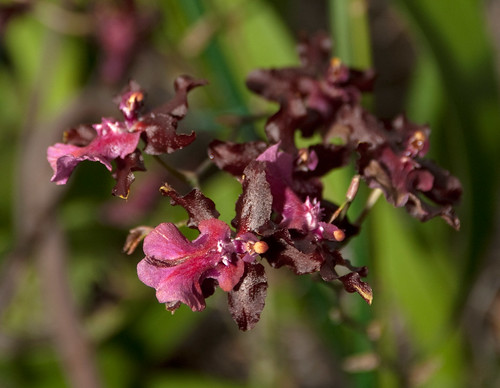Tip of the Week: Fragrant Orchids
Posted in Gardening Tips on March 29 2010, by Sonia Uyterhoeven
 |
Sonia Uyterhoeven is Gardener for Public Education. For hands-on demonstrations and orchid tips, join her in the Conservatory’s GreenSchool every Saturday and Sunday at 2 p.m. throughout The Orchid Show. |
 While we revel in the wonderful fragrance of many orchids, it is important to remember that fragrance plays an essential role in their survival strategy. Just as we may wear perfume to seduce a mate, orchids spice up their lives to attract pollinators—bees, wasps, flies, butterflies, hummingbirds, moths, gnats, and beetles.
While we revel in the wonderful fragrance of many orchids, it is important to remember that fragrance plays an essential role in their survival strategy. Just as we may wear perfume to seduce a mate, orchids spice up their lives to attract pollinators—bees, wasps, flies, butterflies, hummingbirds, moths, gnats, and beetles.
Flowers that are pollinated by insects are often brightly colored and fragrant. They are advertising the fact that they offer nectar or other substances for different creatures to feed on. Pollinators pick up the sticky pollen as they feed and transfer it to other flowers.
Every orchid species has its own unique strategy to attract pollinators. Some have wonderful fragrances yet produce no nectar, tricking insects looking for a meal. Other orchids such as Ophrys and Chiloglottis produce odors that mimic the pheromones of bees and wasps (some even look like female insects) so that the males try to mate with the orchids. Some bees even collect the orchid’s fragrance and store it on their hind legs, perhaps to use to attract their own mates.
Flies, gnats, and beetles are attracted to dull-green and reddish-brown orchids with foul odors. The noxious Bulbophyllum beccarii attracts flies by smelling like decaying animals. Butterflies and hummingbirds tend to gravitate to bright yellow and red flowers that are full of sweet nectar. Bees love nectar and cheerful flowers that range from purples and blues to bright yellows.
Most orchids smell best in the morning hours when the light is bright. The fragrance fades in the afternoon when the temperature heats up. This corresponds with the pollination practices of insects that are more active in early hours. Other orchids are fragrant in the evening. The well-known “queen of the night,” Brassavola nodosa, starts exuding its heavenly fragrance at dusk when its pollinators, nocturnal moths, come out.
Fragrances are volatile. They often develop and become more complex the longer you smell them. A fragrance may catch your attention with a strong citrus smell that sweetens and becomes floral after a few minutes. For example, at first Dendrobium anosmum smells like raspberry, then shifts to strawberry, rhubarb, and finally, hyacinth.
Many factors affect fragrance. Orchids tend to be more fragrant on sunny days, when the volatile oils warm up and diffuse. Fragrances tend to linger longer in areas of high humidity.
Over the past several decades, a greater emphasis has been placed on hybridizing fragrant orchids. They are judged at shows by panels that consist of orchid experts and members from the perfume industry. Fragrances are assessed in terms of their intensity and complexity. Expert perfumers train for up to six years and can identify 3,000 distinct odors.
How then should the common person smell orchids? Some stick their nose just above the flowers and inhale (without handling the flower to avoid damaging the petals). Others wave their hand above the orchid in the hope of drawing the odor out of the flower. Whichever method you choose, the important thing is to take time to stop and smell the orchids.
Popular Fragrant Orchids
The majority of the orchids listed below are appropriate for the beginner/early intermediate grower. If you are looking for a more comprehensive list, read Steven Frowine’s delightful book, Fragrant Orchids, available at Shop in the Garden. An experienced grower, Frowine provides excellent tips for growing fragrant orchids in your home.
Brassavola nodosa (lily-of-the-valley)
Brassavola ‘Little Stars’ (sweet)
Cattleya alliance: includes Cattleya (C), Laeliocattleya (Lc.) and Brassolaeliocattleya (Blc.). Orchids from the Cattleya alliance tend to have floral, sweet, citrus fragrances.
Cochleanthes amazonica (spicy, candy)
Dendrobuim anosmum (raspberry, strawberry or rhubarb)
Dendrobuim parishii (berries)
Dendrobium nobile (floral)
Encyclia fragrans (vanilla, honey)
Encyclia radiata (coconut)
Lycaste aromatica (cinnamon)
Maxillaria tenuifolia (coconut)
Miltoniopsis (rose)
Neofinetia falcata (coconut and jasmine)
Oncidium Sharry Baby (chocolate and vanilla)(pictured, above)
Oncidium Twinkle (vanilla)
Oncidium Hawaiian Sunset (floral)
Oncidium cheirophorum (sweet, citrus)
Oncidium ornithorhynchum (vanilla)
Phalaenopsis Caribbean Sunset (rose)
Phalaenopsis Coral Isles (citrus)
Phalaenopsis Orchid World ‘Roman Holiday’ (spicy)
Phalaenopsis schilleriana (rose)
Phalaenopsis violacea (floral)
Vanda coerulescens (grape bubble gum)
Zygopetalum (hyacinth)


HI-
May I use this article, giving you authorship, in our orchid society newsletter?
Please let me know ASAP since I am trying to get out the newsletter this week.
Thank you!